
Vrindavan, also spelt Vrindaban and Brindaban, is a historical city in the Mathura district of Uttar Pradesh, India. It is located in the Braj Bhoomi region and holds religious importance for Hindus who believe that Krishna, one of the main Gods in Hinduism, spent most of his childhood in this city. Vrindavan has about 5,500 temples dedicated to the worship of Krishna and his chief consort, Radha. It is one of the most sacred places for Vaishnava traditions.
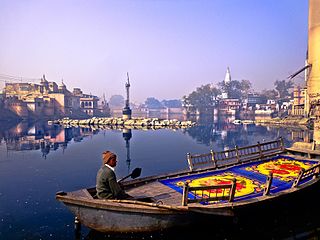
Mathura district is situated along the banks of the river Yamuna is a district of Uttar Pradesh state of north-central India. The historic city of Mathura is the district headquarters. Mathura district is home to many important sites associated with goddess Radha and Lord Krishna, who was born in Mathura and grew up in the nearby town of Vrindavan. Both cities are some of the most sacred sites in the Vaishnava tradition, making Mathura district an important Hindu pilgrimage centre.

Sanatana Goswami was a principal follower of Chaitanya Mahaprabhu. Sanatana wrote a number of works in the bhakti tradition of Gaudiya Vaishnavism and was the senior most of the influential Six Goswamis of Vrindavan, among whom was his brother Rupa Goswami.
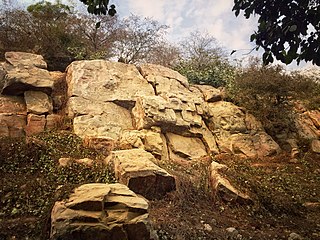
Govardhana Hill, also called Mount Govardhana and Giriraj, is a sacred Hindu site in the Mathura district of Uttar Pradesh, India on an 8 km long hill located in the area of Govardhan and Radha Kund, which is about 21 kilometres from Vrindavan. It is the sacred centre of Braj and is identified as a natural form of Krishna, the Govardhana Shila.

Radha Kund is a town and nagar panchayat in Mathura district in the Indian state of Uttar Pradesh. It is also one of the pilgrimage sites dedicated to Hindu goddess Radha.

Gopala Bhatta Goswami (1503–1578) is one of the foremost disciples of the Vaishnava saint, Chaitanya Mahaprabhu, and a historical figure in the Gaudiya Vaishnava school of Hinduism. He was part of a group of Vaishnava devotees known collectively as the Six Goswamis of Vrindavan, who were influential in establishing the philosophical basis of the Gaudiya tradition in formalised writings.

Gadadhara Pandita, also known as Pandita Goswami, was a close childhood friend of Chaitanya Mahaprabhu, the founder of the Hindu tradition of Gaudiya Vaishnavism.
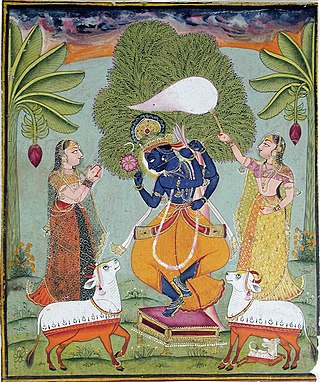
Gopinath or Gopinatha is a form of the Hindu god Krishna. It is also one of the primary names of Krishna, meaning, "the lord of the cowherdesses".
Vraja Mandal Parikrama, also called VrajaYatra, is a Nimbarka Sampradaya Hindu pilgrimage dedicated to Krishna. At present Vraja Parikrama Pradhan Mahant Sri Sri 108 Swami Rasbiharidas Kathiababaji Maharajji of 84 kos Vraja region (Braja) which takes 1 to 2 months depending on the route and speed of travel on foot. The Nimbarka Sampradaya tradition Vaishnava Nagaji Maharaj only performed 84 crore Vraja Parikrama 530 years ago. Since this is a site associated with Krishna and the Mahabharata, it is an important place of pilgrimage for Hindus. It is one of 3 main pilgrimage sites related to the Krishna circuit, namely the 48 kos parikrama in Haryana, Braj parikarma in Mathura in Uttar Pradesh, and Dwarkadhish temple pilgrimage in Gujarat.
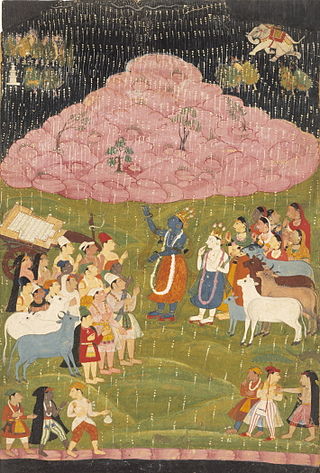
The Govardhana Shila is a rock from the Govardhana Hill in Braj, Uttar Pradesh, India. Govardhan Hill holds a unique position in Hindu scriptures related to Krishna, the land called Braj where He was born. Known as Govardhan or Giriraj and being the sacred centre of Braj, it is identified as a natural form of Krishna. Indian art overwhelmingly prefers the iconic image, but some aniconism does occur in folk worship, early Buddhism, Shiva's Banalinga, and Vishnu's Shaligrama). They have solar significance, and their use in worship predates the Hindu period in India. The stone is usually brown in colour.

Radha Ramana is one of the combined forms of the Hindu deities Radha and Krishna, besides their BankeBihari and Radha-Vallabha forms.

ISKCON Vrindavan, also called Sri Krishna Balaram Mandir, is one of the major ISKCON temples in the world. It is a Gaudiya Vaishnava temple located in the city of Vrindavan, Mathura district, in the Indian state of Uttar Pradesh. The temple is dedicated to the Hindu gods Krishna and Balarama. The other deities of temple are Radha Krishna and Gauranga Nityananda.
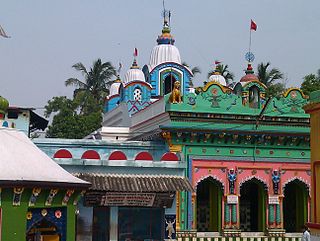
Kshirachora Gopinatha Temple is a Hindu temple in Remuna, Odisha, India. The name "Remuna" is from the word "Ramaniya" which means very good-looking. "Kshirachora" in Odia means Stealer of condensed Milk and Gopinatha means the Divine Consort of Gopis. The reference is to child Krishna's love for milk and milk products. It is Classified one among the 108 Abhimana Kshethram of Vaishnavate tradition.

Sri Radha Raman Temple, is a Hindu temple situated in Vrindavan, India. It is dedicated to Krishna who is worshiped as Radha Ramana. This temple is counted as one of the Seven most revered ancient temples of Vrindavan along with Radha Vallabh Temple, Radha Damodar Temple, Radha Madanmohan Temple, Radha Govindji Temple, Radha Shyamsundar Temple and Radha Gokulnandan Temple. The temple houses the original Shaligram deity of Krishna alongside goddess Radha.

Shri Radha Madan Mohan Ji Temple is a Hindu temple situated at Karauli, in the Indian state of Rajasthan. The temple is located on the banks of the Bhadravati River, a tributary of the Banas River in the hills of Aravali. It is located in the braj region. The temple is dedicated to Madan Mohan form of Krishna. In the central altar, Krishna is flanked with the icons of his consort Radha and Lalita on either side.

Kusum Sarovar is a sacred water reservoir with a historic sand monument in its backdrop. It is situated on the holy Govardhan Hill between Manasi Ganga and Radha Kund in Mathura district of Uttar Pradesh, India. Kusum Sarovar is considered one of the sacred spots that witnessed the pastimes of Hindu deities Radha and Krishna. It is also the place of Jat ruler Maharaja Suraj Mal's memorial chhatri. Kusum Sarovar has Narada Kund, where Bhakti Sutra verses were written by Narada and the Shri Radha Vana Bihari Temple in the vicinity.
Gopal or Gouda is an Indian caste, from Odisha State in East India. Their traditional occupations include dairy farming, cattle herding, cultivation and carrying palanquins of deities. They also worked as Paikas (soldiers) under the kings. Gopal is the name of the milkmen or herdsmen caste in Odisha, which is known by other names in various parts of India.

Shri Radha Madan Mohan Temple, is a Hindu temple situated in Vrindavan of Indian state of Uttar Pradesh. It is one of the oldest and highly revered temple of Vrindavan. The presiding deity of the temple is Madan Mohan, a form of the god Krishna who is present in the central altar of the temple with his consort goddess Radha and Lalita gopi on either sides of him. The temple is one of the earliest temples of Vrindavan which has architectural influences from existing Mughal architecture and as well as Kalinga Nagara Style of Indian Temple Architecture.

Shri Radha Damodar Temple is a Hindu temple, dedicated to Hindu deities Radha and Krishna. The temple is situated in Vrindavan of Indian state Uttar Pradesh. In the temple, Krishna is worshiped in the form of Damodar with his consort Radha. It is one of the main seven Goswami temples of Vrindavan. The temple belongs to Gaudiya Vaishnavism tradition and was founded by Jiva Goswami in 1542 CE.

The Ashtasakhi are a group of eight prominent gopis and close associates of the Hindu deities Radha-Krishna in the Braj region. In many sub-traditions of Krishnaism, they are revered as goddesses and consorts of Krishna. According to the Padma Purana, the Ashtasakhi are the eternal female companions of Radha and Krishna in the Dvapara Yuga, with whom they descended upon the earth from their celestial abode of Goloka.




















